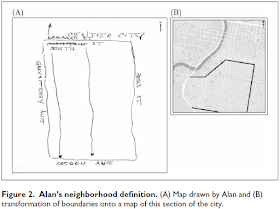 |
| Mural of a couple Flickr/Susan Semoneta citylab.com |
It is time once again to go through the drop box folder and pull out some long neglected articles. Today's post is an article by Richard Florida published in March of this year in CitylLab, titled "How Gentrifiers Change the Definition of a Neighborhood." It is a discussion of research conducted in Philadelphia, Pennsylvania which revealed that race was the biggest indicator of how residents defined their changing neighborhoods. Whether it was change for the better or worse remains to been but the study looked how those differences in community definition can have a wide reaching effect on the future.
Richard Florida begins by quoting director Spike Lee who ranted to audience exactly how he felt about gentrification:
[W]hy does it take an influx of white New Yorkers in the south Bronx, in Harlem, in Bed Stuy, in Crown Heights for facilities to get better?...You can't discover this! We been here. You just can't come and bogart...What do they call Bushwick now? What's the word? [Audience: East Williamsburg]...(expletive)...These real estate (expletive) are changing names! Stuyvesant Heights? 110th to 125th, there's another name for Harlem. What is it? What is it? What is it? No, no, not Morningside Heights. There's a new one. [Audience: SpaHa] What the (expletive) is that? How you changin' names?
 |
| South Philadelphia street philebrity.com |
This was the main conclusion in a very detailed study published by Harvard University sociologist and doctoral student Jackelyn Hwang. Ms. Hwang's work focused on the gentrifying community in South Philadelphia, centered on interviews conducted on fifty-six residents in 2006. South Philadelphia was once a depopulated, predominantly African-American neighborhood with high poverty and crime. In the late nineties, the western portion of the larger Center City district began a revitalization process. By 2006, when Ms. Hwang undertook her research, the neighborhood became a magnet for for middle- and high-income residents, most of home lived in newly developed townhomes. The median household income soared by 140 percent between 1990 and the mid-aughts, about a little more than $40,000. Also, the racial composition shifted to 50 percent non-Hispanic white.
 |
| Map of research site Jackelyn Hwang citylab.com |
The interviews lasted between 20 minutes to an hour, concentrating on resident perceptions of the neighborhood and how the defined their owned neighborhood and those adjacent. Mr. Florida writes, "Her questions probed the respondents on the neighborhood's changes over time, in particular its identities and boundaries. The respondents were also asked to draw maps of their neighborhoods, complete with boundaries and place names, as a way to better comprehend the cognitive maps they use understand and relate with the places.
 |
| Alan's neighborhood definition LHS: drawn by Alan RHS:transformation of boundaries on map of this section Jackelyn Hwang citylab.com |
Richard Florida writes, "Alan, along with the majority of the non-white respondents, used his map to resist exclusion and 'reify' the neighborhood's older identity in the midst of change. To divide their neighborhood into smaller areas would, in their view, be 'inauthentic.'" Interestingly, the Caucasian participants did not identify the neighborhood as "South Philly," choosing the newer monikers of "Graduate Hospital," "G-Ho" (that can have all sorts of connotations), "South Rittenhouse," and "Southwest Center City." They often expressed ambivalence about boundaries and as a result skewed toward using less conventional boundary markers. For example:
 |
| Melissa's neighborhood definition LHS: drawn by Melissa RHS:transformation of boundaries on map of this section Jackelyn Hwang citylab.com/popist.com |
Eventually, Ms. Hwang discovered "...that neighborhoods and their boundaries have important symbolic meanings." She writes in her study, the way residents define their communities ignites whether or not a group feel that they fit with the identity associated with a space and their strategies to exclude or include other to make the neighborhood identity align with with their personal identity. A Harvard University study is really not necessary to measure the way Caucasian and African-American residents identify their Philadelphia neighborhood regardless of income or length of residency.
 |
| Giordano South Philadelphia michaelangelina.com |
 |
| South Street Bridge Philadelphia, Pennsylvania visitphilly.com |
 |
| South Street Headhouse District Philadelphia, Pennsylvania southstreet.com |
Be that as it may, Ms. Hwang echoes Jane Jacobs, finding real neighborhoods have more dynamic characteristics. Neighborhoods do change and change dramatically. She found that the issue of how we define neighborhoods has particular relevance in neighborhoods in states of flux. Ms. Hwang writes,
Most whites defined the areas as many things, except how minority respondents defined the area...The large and inclusive socially constructed neighborhood was eventually replaced. In short, the gentrifiers won out.
No comments:
Post a Comment